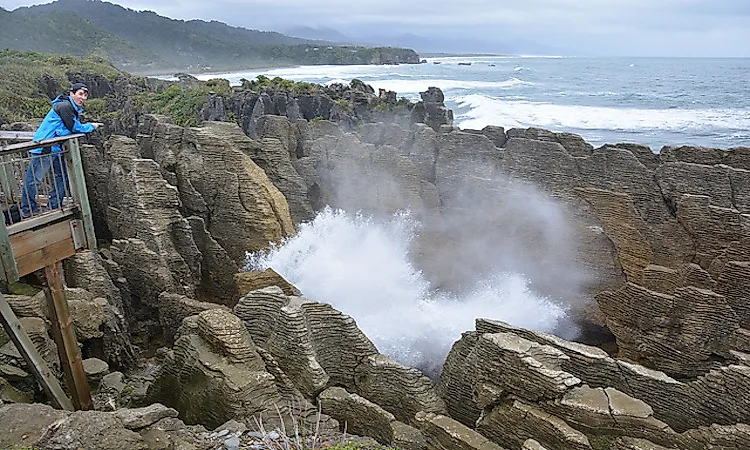Coastal Landforms: What Is A Blowhole?

What Is A Blowhole?
When sea caves grow towards the land and upwards creating a vertical shaft that exposed on the surface, it results in a blowhole. Water often gushes out at the top part of the landform when waves move to the sea cave with significant force. The activities of the blowhole depend on the sea conditions as well as its geometry and that of the sea cave. A blowhole is characterized by an opening on the ground and a connection to an opening which interacts with the sea, mostly a cave.
Formation Of A Blowhole
Sea Caves are a common feature along the coasts and are formed through mechanical erosion of cliffs. Parts of weakness in the cliffs are weathered out by wave action thereby forming large cavities known as sea caves. These caves are regularly exposed to waves. Hydraulic pressure, built up by a succession of waves, eventually carves out a hole at the top of the cave to create an opening for water pressure to be expelled as a jet of spray. A blowhole can also be formed when lava flows make openings in the ground which extend towards the sea. The landform manifests as a crack or fissure once formed.
Where Are Blowholes Located?
Blowholes are mainly located in regions with crevices in the coastal rocks. Such areas have been mapped out as lying along fault lines and on islands. Water enters these crevices when there are powerful waves in the sea, and it is released in the form of jet sprays through the blowhole. The jet sprays often create a loud noise as they gush out.
Examples Of Blowholes
The world’s largest blowhole is found in Nakelele Point in Hawaii. Water jets from this blowhole can reach a height of 100 feet. The blowhole is located near Poelua Bay, and its name translates to “the leaning” in the local language. This blowhole is notably known for causing several deaths through suction in the returning water or falling into the hole. The Hummanaya Blowhole is the world’s second largest of this landform, and it is located in Sri Lanka. The blowhole generates a spectacular water fountain in intervals of several minutes which can shoot up to 98 feet depending on sea conditions. The blowhole has promoted tourism in the area, and a viewing platform has been erected for the tourists who visit the region. In Southwest Savaii, Samoa is the impressive Aloofaga Blowholes. Locals sometimes throw coconuts in them and witness as they are blasted into the air. The blowholes are one of the primary attractions in Samoa. Other blowholes include the Kiama Blowholes in Australia and the blowholes of Wupatki National Monument, US.
Impacts Of Blowholes
Continued action of blowholes eventually changes the topography around it. The holes cause erosion of the region around the crevices and lead to the enlarging of the sea caves. The entire cave can even collapse in some cases. Once this action takes place, a shallow pool is created along the coastline. Blowholes are major tourist attractions due to the display of gushing water. The landform is, however, dangerous since the area around it is weak and can fold at any moment and claim people’s lives.











